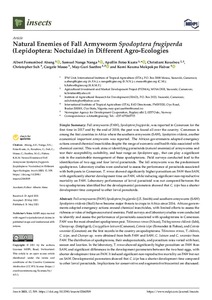| dc.contributor.author | Abang, A. |
| dc.contributor.author | Nanga, S.N. |
| dc.contributor.author | Fotso Kuate, A. |
| dc.contributor.author | Kouebou, C. |
| dc.contributor.author | Suh, C. |
| dc.contributor.author | Masso, C. |
| dc.contributor.author | Saethre, M.G. |
| dc.contributor.author | Fiaboe, K. |
| dc.date.accessioned | 2021-07-08T15:10:39Z |
| dc.date.available | 2021-07-08T15:10:39Z |
| dc.date.issued | 2021 |
| dc.identifier.citation | Abang, A., Nanga, S.N., Fotso Kuate, A., Kouebou, C., Suh, C., Masso, C., ... & Fiaboe, K. (2021). Natural enemies of fall armyworm Spodoptera frugiperda (Lepidoptera: Noctuidae) in different agro-ecologies. Insects, 12(6), 509: 1-23. |
| dc.identifier.issn | 2075-4450 |
| dc.identifier.uri | https://hdl.handle.net/20.500.12478/7168 |
| dc.description.abstract | Fall armyworm (FAW) Spodoptera frugiperda (J.E. Smith) and southern armyworm (SAW) Spodoptera eridania (Stoll) have become major threats to crops in Africa since 2016. African governments adopted emergency actions around chemical insecticides, with limited efforts to assess the richness or roles of indigenous natural enemies. Field surveys and laboratory studies were conducted to identify and assess the performance of parasitoids associated with spodopterans in Cameroon. FAW was the most abundant spodopteran pest. Telenomus remus (Nixon), Trichogramma chilonis (Ishi), Charops sp. (Szépligeti), Coccygidium luteum (Cameron), Cotesia icipe (Fernandez & Fiaboe), and Cotesia sesamiae (Cameron) are the first records in the country on spodopterans. Telenomus remus, T. chilonis, C. icipe, and Charops sp. were obtained from both FAW and SAW; C. luteum and C. sesamiae from FAW. The distribution of spodopterans, their endoparasitoids, and parasitism rates varied with host, season and location. In the laboratory, T. remus showed significantly higher parasitism on FAW than SAW, and significant differences in the development parameters between the two host eggs, with shorter development time on FAW. It induced significant non-reproductive mortality on FAW but not on SAW. Developmental parameters showed that C. icipe has a shorter development time compared to other larval parasitoids. Implications for conservative and augmentative biocontrol are discussed. |
| dc.description.sponsorship | World Bank |
| dc.description.sponsorship | Cameroon Government |
| dc.format.extent | 1-23 |
| dc.language.iso | en |
| dc.subject | Spodoptera Frugiperda |
| dc.subject | Parasitoids |
| dc.subject | Pests of Plants |
| dc.subject | Pests |
| dc.subject | Biological Control |
| dc.subject | Cameroon |
| dc.subject | Agroecology |
| dc.title | Natural enemies of fall armyworm Spodoptera frugiperda (Lepidoptera: Noctuidae) in different agro-ecologies |
| dc.type | Journal Article |
| cg.contributor.affiliation | International Institute of Tropical Agriculture |
| cg.contributor.affiliation | Agricultural Investment and Market Development Project, Cameroon |
| cg.contributor.affiliation | Institute of Agricultural Research for Development, Cameroon |
| cg.contributor.affiliation | Norwegian Agency for Development Cooperation |
| cg.coverage.region | Africa |
| cg.coverage.region | Central Africa |
| cg.coverage.country | Cameroon |
| cg.coverage.hub | Central Africa Hub |
| cg.researchtheme | Natural Resource Management |
| cg.researchtheme | Plant Production and Health |
| cg.identifier.bibtexciteid | ABANG:2021 |
| cg.isijournal | ISI Journal |
| cg.authorship.types | CGIAR and developing country institute |
| cg.iitasubject | Agronomy |
| cg.iitasubject | Disease Control |
| cg.iitasubject | Food Security |
| cg.iitasubject | Natural Resource Management |
| cg.iitasubject | Pests of Plants |
| cg.iitasubject | Plant Breeding |
| cg.iitasubject | Plant Health |
| cg.iitasubject | Plant Production |
| cg.journal | Insects |
| cg.notes | Open Access Journal; Published online: 31 May 2021 |
| cg.accessibilitystatus | Open Access |
| cg.reviewstatus | Peer Review |
| cg.usagerightslicense | Creative Commons Attribution 4.0 (CC BY 0.0) |
| cg.targetaudience | Scientists |
| cg.identifier.doi | https://dx.doi.org/10.3390/insects12060509 |
| cg.iitaauthor.identifier | Albert ABANG: 0000-0002-2791-9557 |
| cg.iitaauthor.identifier | Samuel Nanga: 0000-0003-4281-8284 |
| cg.iitaauthor.identifier | Fotso Kuate, A.: 0000-0002-5247-7519 |
| cg.iitaauthor.identifier | May-Guri Sæthre: 0000-0001-8819-9154 |
| cg.iitaauthor.identifier | Komi Fiaboe: 0000-0001-5113-2159 |
| cg.futureupdate.required | No |
| cg.identifier.issue | 6: 509 |
| cg.identifier.volume | 12 |
| cg.contributor.acknowledgements | The laboratory technicians Jean Remi AYO AYO, Alvine DONFACK, and Carole MEJANE also played a key role in rearing species, the production of colonies, and the biological tests conducted. The authors are grateful to Andrew Polaszek and Gavin Broad of the Natural History Museum for the identification of parasitoids. |

